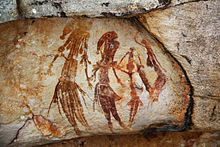Wikijunior:Introduction to History/So, where did humans start?/Stone age

The first million years of human existence is called the stone age. People spread out over the earth, from the hot jungles to the freezing north. A few tens of thousands of years ago, something wonderful happened. People began to develop new tools, new forms of art, musical instruments, and began to bury their dead. Before that time, primitive tools from widely separated places look very much alike. After that time, human artefacts take on an almost infinite variety of distinctive forms. This is the age of the cave paintings, of the European drawings of buffalo and the African drawings of antelope. These works of art differ not only in subject but in style. This age is called the Neolithic age (or new stone age). In 2005, scientists isolated two genes that they think may be the cause of this wonderful change, but the discovery is too new for anybody to say for sure.
Stone age peoples were hunter-gatherers. They ate animals and what roots and berries they could find growing wild. There was never enough food, and so people organized into tribes and constantly fought with other tribes. Many of the bones dug up from this period show signs of wounds from spears or clubs. Life was, as a writer named Hobbes put it, "nasty, brutish, and short."